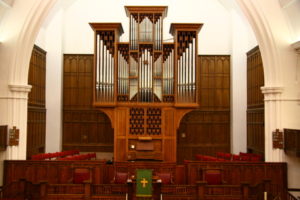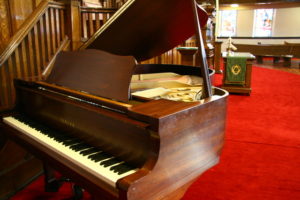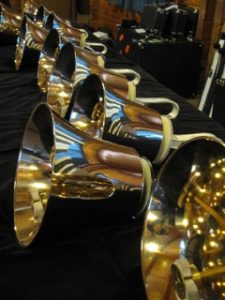Musical Instruments of Robertson-Wesley




Gabriel Kney Organ
Classical Style
The organ in Robertson-Wesley was installed in the summer of 1979. It is the 91st organ to be built in the shop of Gabriel Kney of London, Ontario. The instrument was dedicated to the Glory of God on Sunday, September 16th, 1979.
The organ is built in the classical (neo-Baroque) style. It is housed in a free-standing red oak reflective case, finished to blend with the existing woodwork of the Church. The action is mechanical (or “tracker”), a system whereby the wind is allowed into the pipes by a mechanical lever action connected directly to the individual keys controlled by the player. Only the console lights and the blower mechanism are electric.
Console and Pipes
The 36 stop console has three keyboards, or manuals, a full pedalboard, and two mechanical levers. The 2,750 pipes, which are made of metal or wood vary in size from ¼ inch to 8 feet in length, arranged in four divisions of 54 ranks total. The three manual divisions are placed one above the other flanked by the two towers of the pedal division. The façade pipes, displaying the “principal” stops in each division, are made of polished tin. The console is terraced and stop nomenclature is German, with special calligraphy created by Friedrich Peter of the University of British Columbia.
Tonal Design and Maintenance
Tonal design is by Bruce Wheatcroft, tonal finishing and voicing is by Gabriel Kney. Tonal revision of the pedal reeds was done in late 1988 by Stephen Miller of Pipeworks Ltd. of Calgary.
History
The Gabriel Kney organ is the third instrument for Robertson-Wesley Church. The original instrument, built by Casavant Freres of Ste.-Hyacinthe, Quebec, was installed in the new Robertson Presbyterian Church in 1914 and was in constant use until 1955.
In 1956, this organ was completely renovated by Casavant with Blanchard Brothers of Winnipeg and Douglas Millson, Music Director of the Church. All of the best stops of the old organ were incorporated into the new one in addition to the ten new stops, the action was electrified, a new motor and blower were installed, and new casework was added. Two additional stops were added in 1974. This organ served the Church until 1979, when it was sold to a Lutheran College in Minnesota to be rebuilt and installed in a chapel there.

Piano
Piano
The piano used in the sanctuary in Robertson-Wesley United Church was purchased in the late 1980’s. It is a Yamaha G2, 5’8” grand. This piano #477 was made in Japan. The cabinet finish is wood grain (walnut). The piano was dedicated to the glory of God in February 1991 in loving memory of Stuart Bird, member of Robertson-Wesley for 51 years. It was a gift from several members of the church and Stuart’s family.

Handbells and Chimes
Handbells
The Robertson-Wesley Ringers and Nova Bells use a 5-octave set of Malmark English handbells, a 4-octave set of Schulmerich handbells, as well as 5 octaves of Malmark handchimes. Many of these exceptional instruments have been donated as memorial gifts. The Bell Choirs offer a joyful and distinctive sound to worship and other special times in the church and community.


Robertson-Wesley Carillon
Scotia Bell Digital Carillon
In October 2015, the Church Board decided to replace the miniature bell system with a digital carillon bell system. After considerable research, the Scotia Bell 64-bell system was chosen. This system featured an initial library of 100 songs, with the ability to add additional songs to the digital collection, and the ability to schedule songs to play automatically.
Schulmerich Carillon
The previous carillon at Robertson-Wesley was a gift from the Wolfe family in memory of F.J. (Frank) Wolfe (1887–1961) and was dedicated February, 1961. After 55 years of continuous use, the Schulmerich carillon was worn out, and we could no longer rely on replacement parts. Through the generosity of the congregation and the Wolfe family, the new Scotia Bell digital carillon was purchased and installed.
